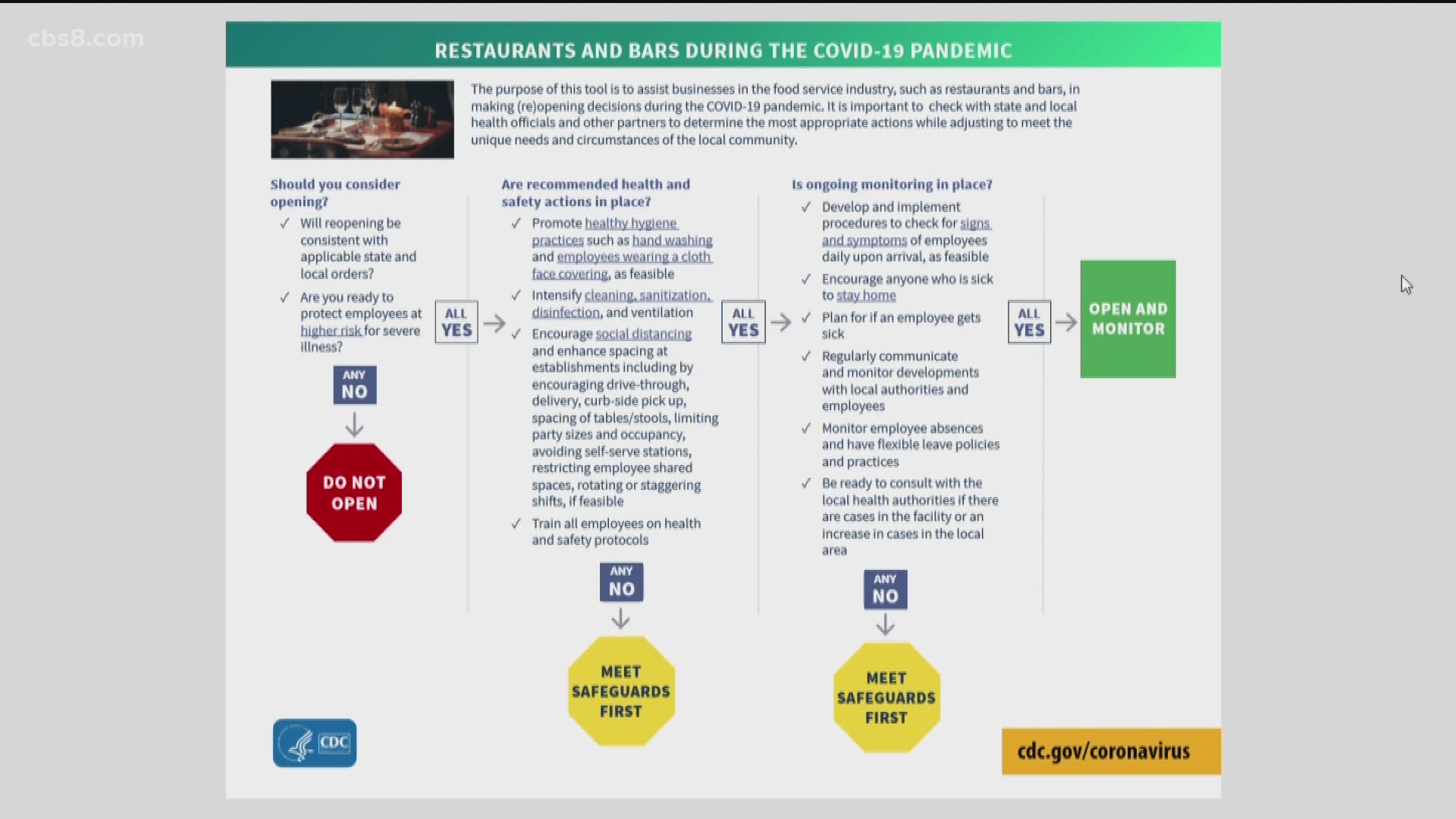WASHINGTON, D.C., USA — On Thursday, the CDC released reopening guidance for 6 different organizations. The 'decision tool' documents were specific to schools, workplaces, camps, childcare centers, mass transit systems, and bars and restaurants and what should be considered before reopening.
Considerations for K-12 schools
1). Schools must adhere to state and local health orders
2). Schools must protect employees and students that are "high risk" such as students with severe asthma, obesity, diabetes, liver disease, etc.
3). School must be able to screen students, employees, etc. when they arrive on campus or symptoms or possible exposure
Once a school meets those requirements, schools must adhere to strict hygiene and sanitation practices. This includes handwashing, intensified cleaning, and ventilation. Employees must wear a face covering. Social distancing will also be the new normal for schools. This includes more spacing between students and smaller groups of people. All employees must be trained on health and safety protocols.
Lastly, the schools must sustain these new practices and continuously monitor the health of everyone on campus. For example, anyone who is sick and/or shows symptoms should stay home and there should be a plan in place on how to deal with sick employees and students.
Schools should have regular, solid communication with local health and law enforcement agencies to make sure they are working together to keep up with sanitation and safety policies. This is especially important when it comes time to prepare for an increase in cases locally.
Schools will need a "flexible leave policies and absences."
View the school 'decision tree' released from by the CDC.
In terms of upcoming graduations this year, County Supervisor Nathan Fletcher said the county had developed guidelines for large drive-through events such as drive-through graduations, as some of the region's high schools are proposing. These guidelines include remaining in the vehicle, not allowing any concessions, restrooms or spectators and limiting vehicle occupants to members of the same household.
Colleges and Universities
The CDC has not released any specific guidelines at this time related to schooling beyond K-12.
When it comes to higher education, classes will remain primarily online during the fall term throughout the California State University system, Chancellor Timothy White announced today, saying predictions of possible surges in COVID-19 cases later in the year mandate steps to protect students and faculty.
Speaking to members of the CSU Board of Trustees during an online meeting, White said there will be "limited exceptions for in-person activities that cannot be delivered virtually, are indispensable to the university's core mission and can be conducted within the rigorous standards of safety and welfare."
He said such exceptions could include clinical nursing classes, life- science laboratory courses and interactive architecture or engineering programs.
"But anything done on a campus this fall won't be as it was in the past, it will be different," White said. "... This is a new and expensive reality for us. For those limited courses where in-person instruction is indispensable and can be justified, enrollment per section will be less."
He said social-distancing guidelines will also be mandated, along with personal protective equipment and heightened cleaning standards.
The CSU system moved to a "virtual mode" in mid-March as the coronavirus pandemic heightened. White said planning for the fall term has focused almost exclusively on continued virtual learning, based on experts' predictions about the virus' continued impact. He said infections and deaths are "beginning to plateau or subside in some, but not all, regions of California."
Additionally, many states will face economic difficulties that impact public schools, including here in California.
California's State Superintendent of Public Instruction, Tony Thurmond, issued the following statement on Thursday:
“The COVID-19 crisis has had a disastrous impact on the state’s economy, and the updated projections today offer sobering details of that reality. I want to thank Governor Newsom for working hard to prioritize and preserve public education as one of the vital, core services we must protect as we weather this economic downturn. Today’s updated budget proposal includes a variety of measures designed to avoid permanent cuts to education, which otherwise could have lasting impacts on a generation of students.
“While the measures outlined in today’s proposal are far from what our schools need, we also understand that our state is facing impossible choices under impossible circumstances. I will continue to advocate on behalf of our students and educators through each step of the Legislature’s budget adoption process in the coming weeks.
“We are grateful for the Governor’s proposal to direct $4.4 billion in federal aid to education, a move that recognizes the increased demands on schools and the equity issues and other challenges posed by COVID-19 school closures this spring. Schools are a critical driver of the health and vitality of our communities, and these funds can be used to make necessary modifications so that schools are better prepared to open their doors in the fall.
“We also strongly echo the Governor’s call for Congress to act swiftly and pass the HEROES Act, which will provide immediate financial relief and help us avoid many of the reductions proposed today. Now, more than ever, California needs support from the federal government so that our schools can deal with the unavoidable costs they face as they plan to reopen.
“I want to thank our educators, students, and families who have worked hard to keep learning going during this pandemic. These are extraordinary times, and we will get through this together. We must rise to this challenge and work together to keep services intact for our students as we navigate this crisis.”

